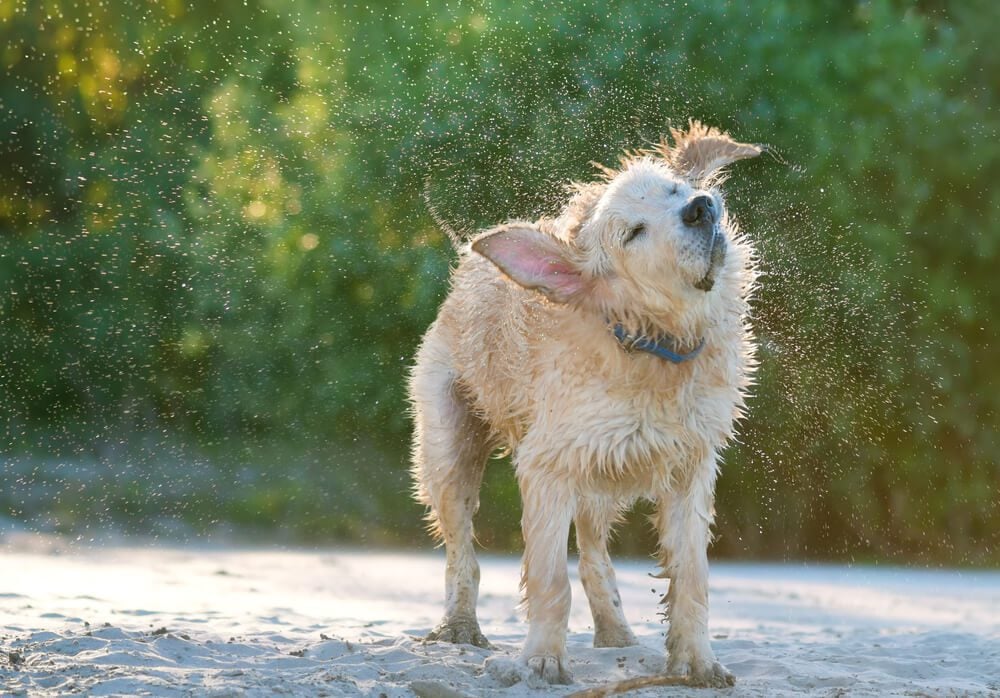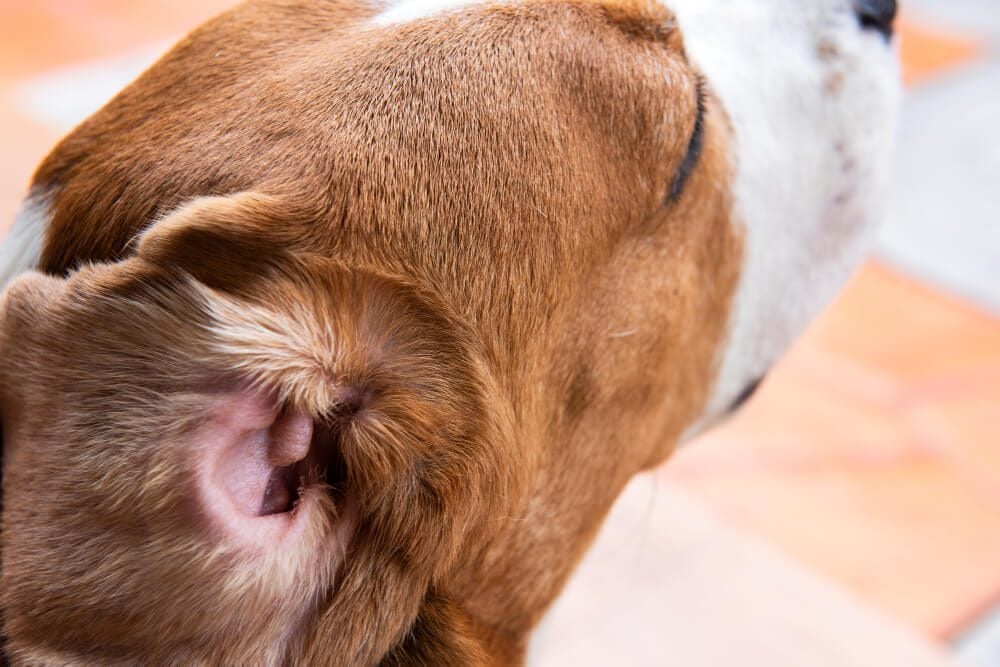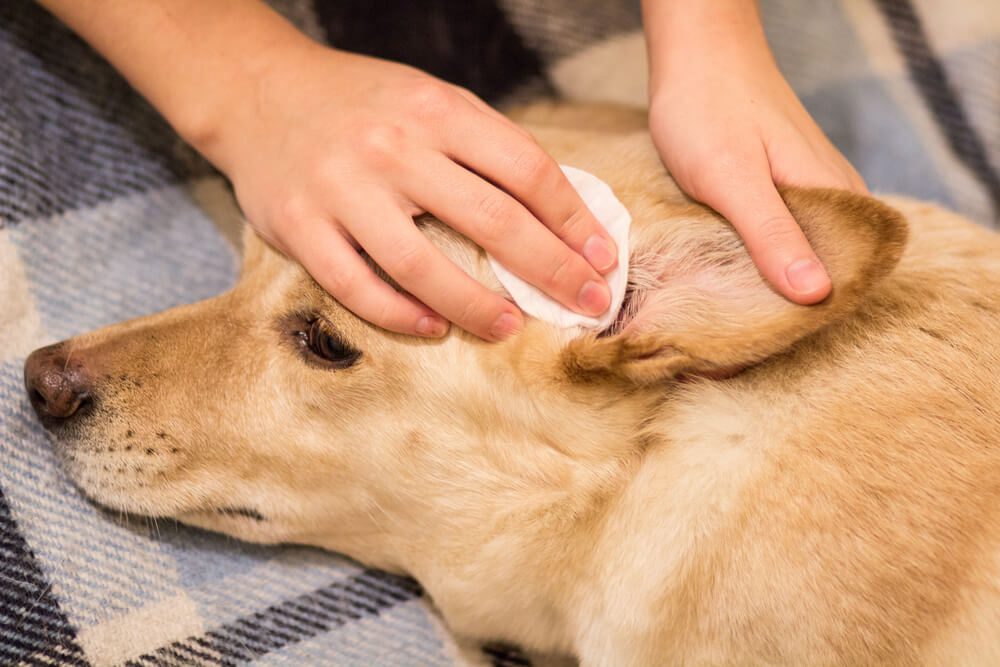Water in Dog Ear 101: Everything You Need to Know

Table of Contents
Is it Normal for a Dog’s Ear to Have Water in it?

No, the presence of water in a dog’s ear is not normal. The dog’s ear is normally dry.
However, a dog’s ear canal is quite long, and water can become trapped there if your dog is an avid swimmer or receives frequent baths.
How Can I Tell if There is Water in Dog Ear?
There are some telltale signs indicating water in a dog’s ear. Here are some of them:
- Head-Shaking: Violent and repeated head-shaking can be your dog’s way of trying to get the water out of its ears.
- Pawing at the Ear: Constant pawing at the ear is a sign the dog is irritated by something inside the ear. This could be an itchy ear or an ear infection, but it is also likely to be water. This should be taken seriously and examined as soon as possible.
- Constant Scratching: If your dog is scratching its ear, it may have water in it. Water in the dog’s ear and excess scratching can lead to open wounds on and around the dog’s ear, which can become infected.
Can Water in a Dog’s Ear Cause an Ear Infection?
Yes, water in a dog’s ears can cause dog ear infection.
In fact, infections are often caused by a high level of moisture in the inner ear. A wet environment allows bacteria to thrive, which can lead to bacterial infection, viral infection, yeast infection, and even ear mites in dogs.
What Happens if Water Gets in My Dog’s Ear?
Most of the time, water in a dog’s ear is not a problem and resolves on its own.
However, when the water in a dog’s ears is copious and present for a long time, it can lead to a number of problems.
Infections, ear pain, and ear discharge are all commonly associated with water that has been left in the ear for too long.
How do You Treat Water in a Dog’s Ear?
Although there are many ways to treat water in a dog’s ears, not every treatment will work to the same extent, and this largely depends on the breed. Some dog breeds will be harder to treat than others. Breeds like Cocker Spaniels, Basset Hounds, and Golden Retrievers, who have larger ears, are more susceptible to trapping water in their ears.

We have listed some of the best options to treat water in a dog’s ear below:
- At-Home Ear Wash. Home remedies are a good option for treating a water-logged ear but should be done very carefully. Combining hydrogen peroxide or apple cider vinegar with equal parts purified water can create an effective ear wash for dog owners. You can use this on a large cotton ball to wash the outside of the ear and on a cotton swab or Q-tip to reach deeper into the inner ear.
- Cleaning Solution. A dog ear cleaner is designed to promote ear health and remove dirt, debris, and excess ear wax buildup. These are effective when used as a preventative treatment for dog ear infections as well.
- Antiseptics. Witch hazel is a great ear cleaner that can be used anywhere outside the ear. When used as an ear cleanser, it can eliminate common causes of ear infections by cleaning the area from the base of the ear to the external ear canal. Witch hazel is safe for dogs when used as a topical solution but should not be applied to dry skin as it could exacerbate the issue.
- Seeing a DVM. In many cases, it may be required to take your dog in to see your DVM. At-home remedies can only be so effective on a dog’s ear canal, which is deep and has angles in it a straight and stiff cotton swab cannot get around. A vet will have the appropriate tools for extracting water from a dog’s ears and can offer treatment to help soothe painful or inflamed ears.
When Should I Take My Dog to the Vet for Water in Their Ear?

There are several common signs that can present themselves to let you know it is time to go to the vet. You should go immediately to the vet for water in the dog’s ear when it shows these signs:
- Dark or Discolored Discharge. Brown or light brown ear wax is normal, but if the discharge is dark, it is often a sign of an infection on the external ear canal, also known as otitis externa. If it is red, it can indicate the presence of blood in the ear wax, and green and dark brown can be a sign of a yeast infection when presented with a foul odor. If your dog’s ear wax is a color other than light brown or yellow, it may be a sign of ear problems.
- Red Ears. If your dog’s ears are red or inflamed, they will be noticeable. It should be taken as a sign of an ear infection and treated as such until your vet can diagnose it appropriately.
- Signs of Ear Infection. When a dog’s ears are hot, it may be running a fever caused by a viral or bacterial infection. If a dog has a red or brown discharge combined with a cheesy or musty smell, it may have a yeast infection. This is treated with antifungal medication that is either given orally or administered directly into the ear canal.
- Imbalance. If your dog’s ear is waterlogged, it may tilt its head to the side of the waterlogged ear. This can make the dog lose its balance, especially in cases of an internal ear infection or otitis interna. Internal diseases can be very serious and result in nausea, deafness, and an inability to blink.
- Loss of Appetite. If an ear issue has developed into an infection, it can cause things like fever and loss of appetite. If your dog has lost their desire to eat, it is time to see a vet.
What Can I Do to Prevent Water in My Dog’s Ear?
The best way to prevent water from getting into your dog’s ears is to avoid water in the first place. However, this can impact a dog’s quality of life, especially if the dog is an avid swimmer.
If this is the case for your dog, then using large cotton balls to block their external ear canals and protect them from water is another good option. Use the cotton balls before swimming or bath time to prevent water from getting down into the dog’s ear and causing trouble.
If you suspect your dog has a waterlogged ear, then the best option is to see a vet. Depending on how long the water has been in the ear, it may have already caused an infection and has not yet shown symptoms.
A vet will be able to treat this, and more so, letting professionals take care of the issue is always the best course of action.

















